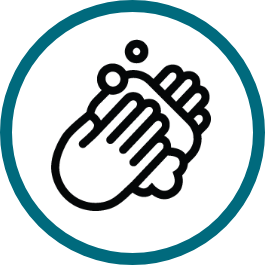Access to safe drinking water among children under five could prevent most diarrheal episodes, and reduce mortality and levels of malnutrition.1Safer water, better health: costs, benefits and sustainability of interventions to protect and promote health.
Prüss-Üstün A, Bos R, Gore F, et al.
World Health Organization
2008 This is a habitual set of behaviors that must be practiced on every occasion by adults, children and babies.

Safe Drinking Water
Family members drink safe water
Key Points from Global Research for Safe Drinking Water
- Keeping the cost of improved water sources low and access nearby can encourage households to regularly use these improved water sources to meet their family’s drinking water needs.
- Promoting the benefits of safe drinking water, especially through health providers and community leaders, can improve safe water collection and storage behaviors in households.
Behavior Profile Sample: Safe Drinking Water
A Behavior Profile is a summary analysis of each behavior. This sample draws from global evidence and illustrates the result of using the Create Behavior Profiles Tool to analyze factors, supporting actors and strategies and to ensure logical pathways exist between strategies proposed and factors related to the practice of the behavior. This sample may be used as a starting point or reference for creating Behavior Profiles.
| Improve maternal and child survival | |
|
Family members drink safe water Indicator: Percentage of households whose main source of drinking water is an improved source
|
Behavior Analysis |
Strategy | ||
|---|---|---|---|
STEPSWhat steps are needed to practice this behavior?
Click on any box |
FACTORSWhat factors may prevent or support practice of this behavior? These should be analyzed for each country context.StructuralAccessibility: Family members do not treat drinking water because it is often difficult to find water treatment products in local markets or health centers Accessibility: Family members do not use safe drinking water because it is usually expensive or time consuming to collect water from improved sources or to treat water SocialNorms: Family members seek safe drinking water because they believe others in the community have adopted safe water behaviors InternalAttitudes and Beliefs: Family members do not drink safe water because they do not like the taste of chemically-treated water Attitudes and Beliefs: Family members do not drink safe water because they believe that drinking treated water is only required during illness Attitudes and Beliefs: Family members collect, treat, and safely store safe drinking water because they are willing to change behaviors to improve their health Knowledge: Family members do not drink safe water because they are unaware of the link between unsafe water and diarrheal episodes Skills: Family members do not treat drinking water because they are unable to correctly use treatment options or equipment |
SUPPORTING ACTORS AND ACTIONSWho must support the practice of this behavior?InstitutionalPolicymakers: Prioritize water and sanitation development projects for rural communities CommunityCommunity Leaders: Model healthy behaviors by adhering to safe water handling and treatment behaviors |
POSSIBLE PROGRAM STRATEGIESHow might we focus our efforts based on this analysis?Enabling EnvironmentFinancing: Support market-based approaches including micro-credit and loans Policies and Governance: Support regulatory reforms that increase and improve the quality of water treatment and storage options available in the market Systems, Products and ServicesInfrastructure: Support national planning to improve water systems development Quality Improvement: Train and equip health care personnel to conduct interpersonal communication with clients on the importance of correct water handling and treatment at all times to prevent disease Demand and UseCollective Engagement: Train and equip community leaders to promote the benefits of correct water handling and treatment within households Skills Building: Develop point-of-use and education interventions at the household-level to train families on correct water handling, treatment options and equipment |
Global Status of Accelerator Behavior
Indicator: Percentage of households whose main source of drinking water is an improved source
The DHS Program Indicator Data API, The Demographic and Health Surveys (DHS) Program


 The Manoff Group was acquired by JSI in 2022.
The Manoff Group was acquired by JSI in 2022.